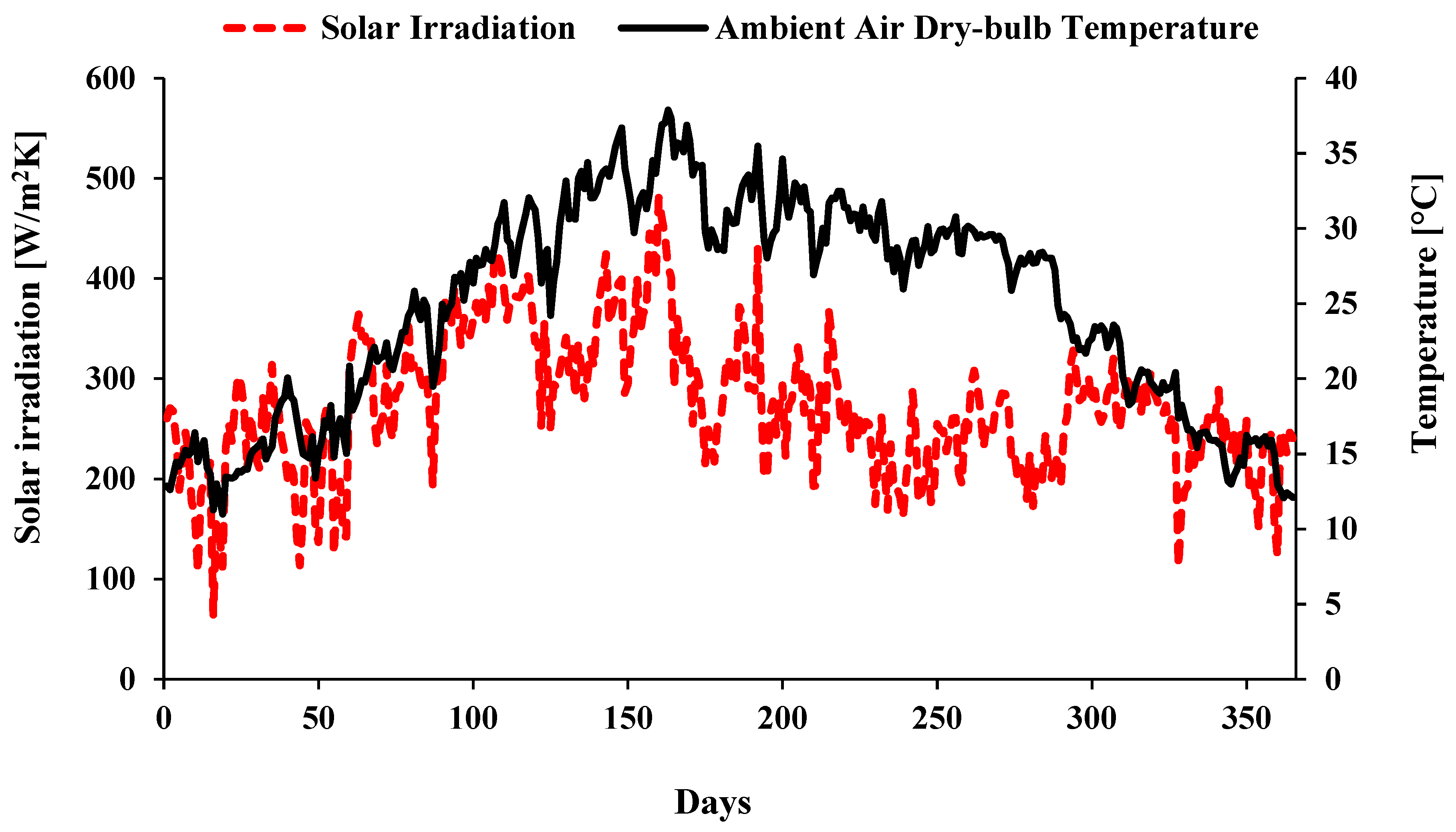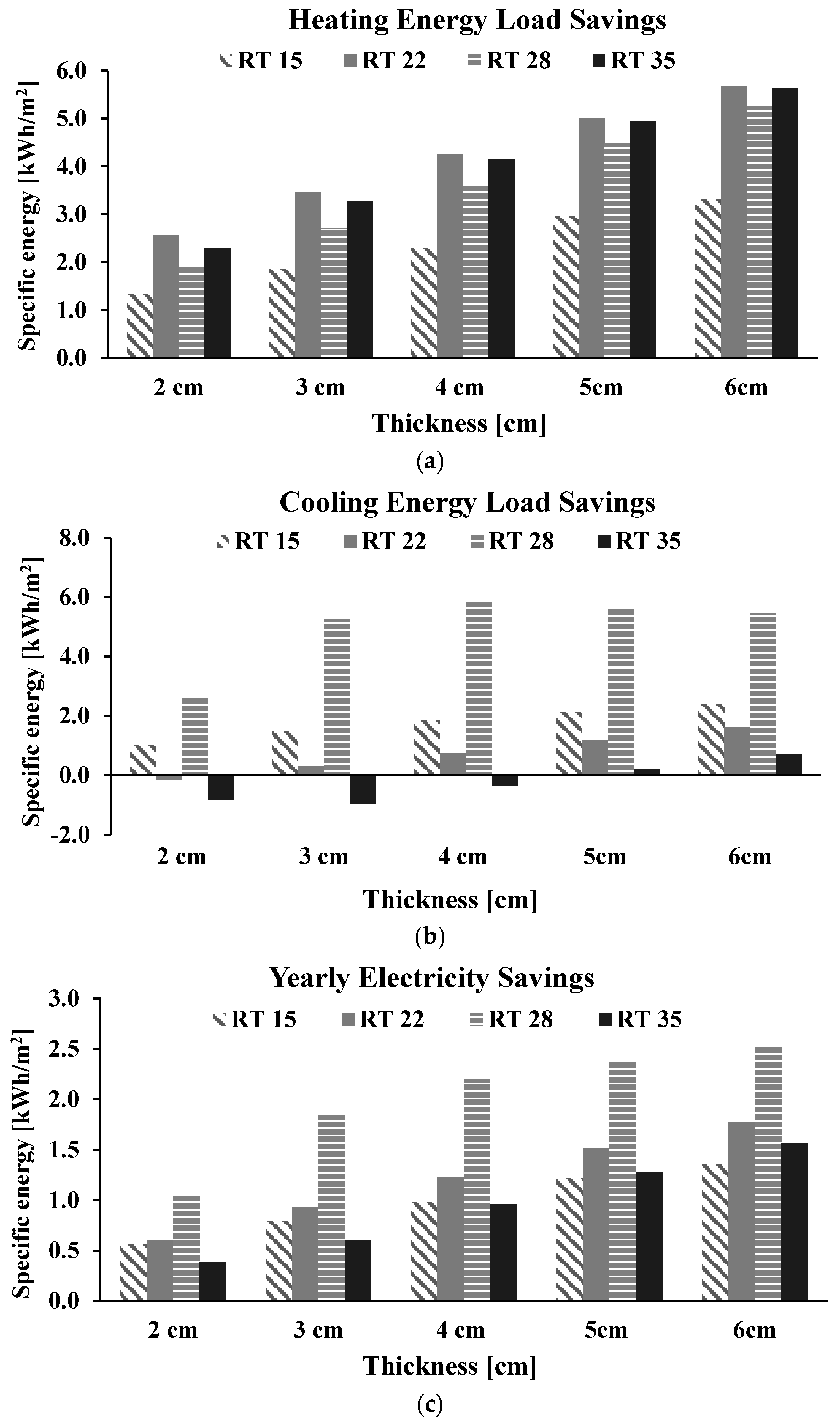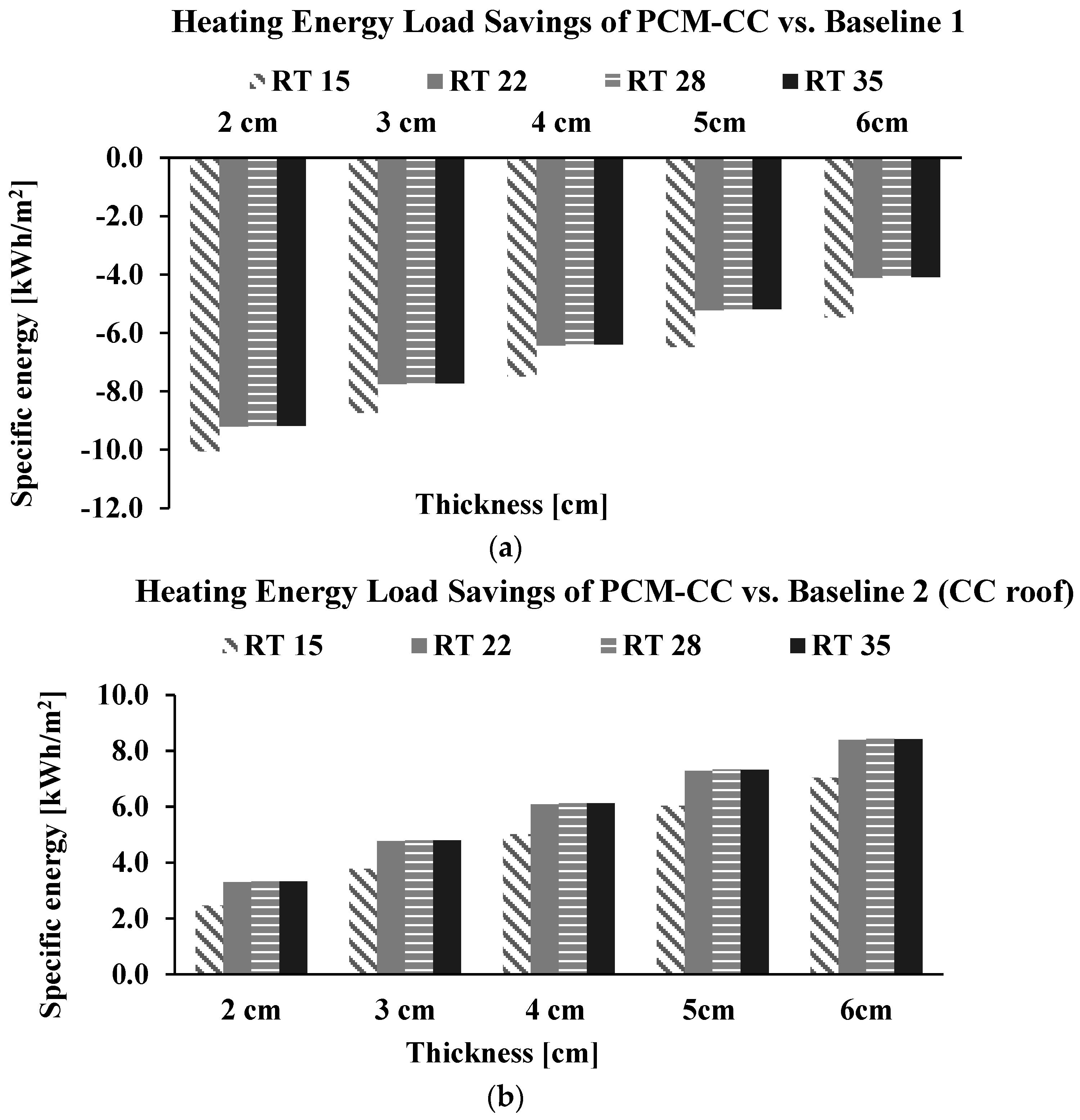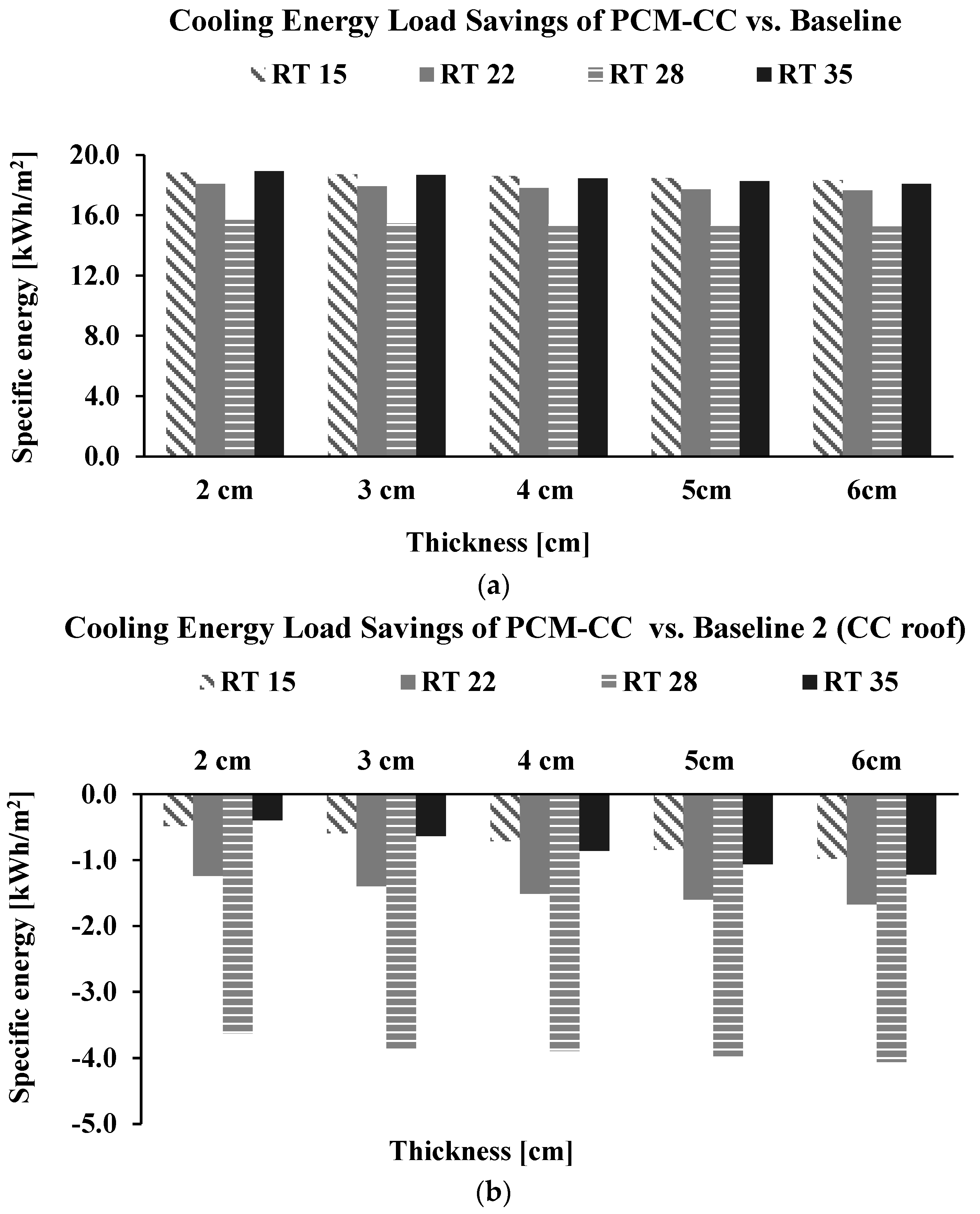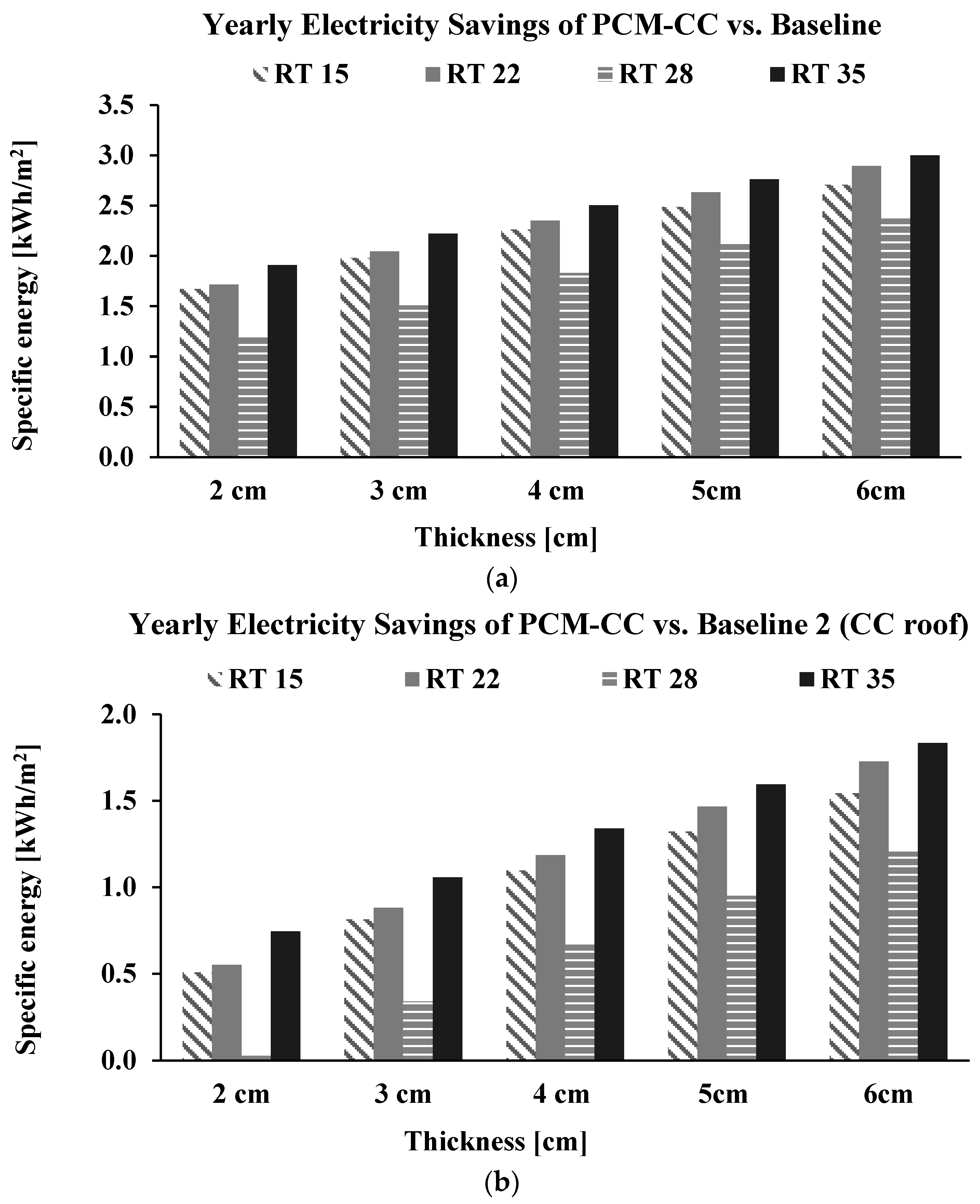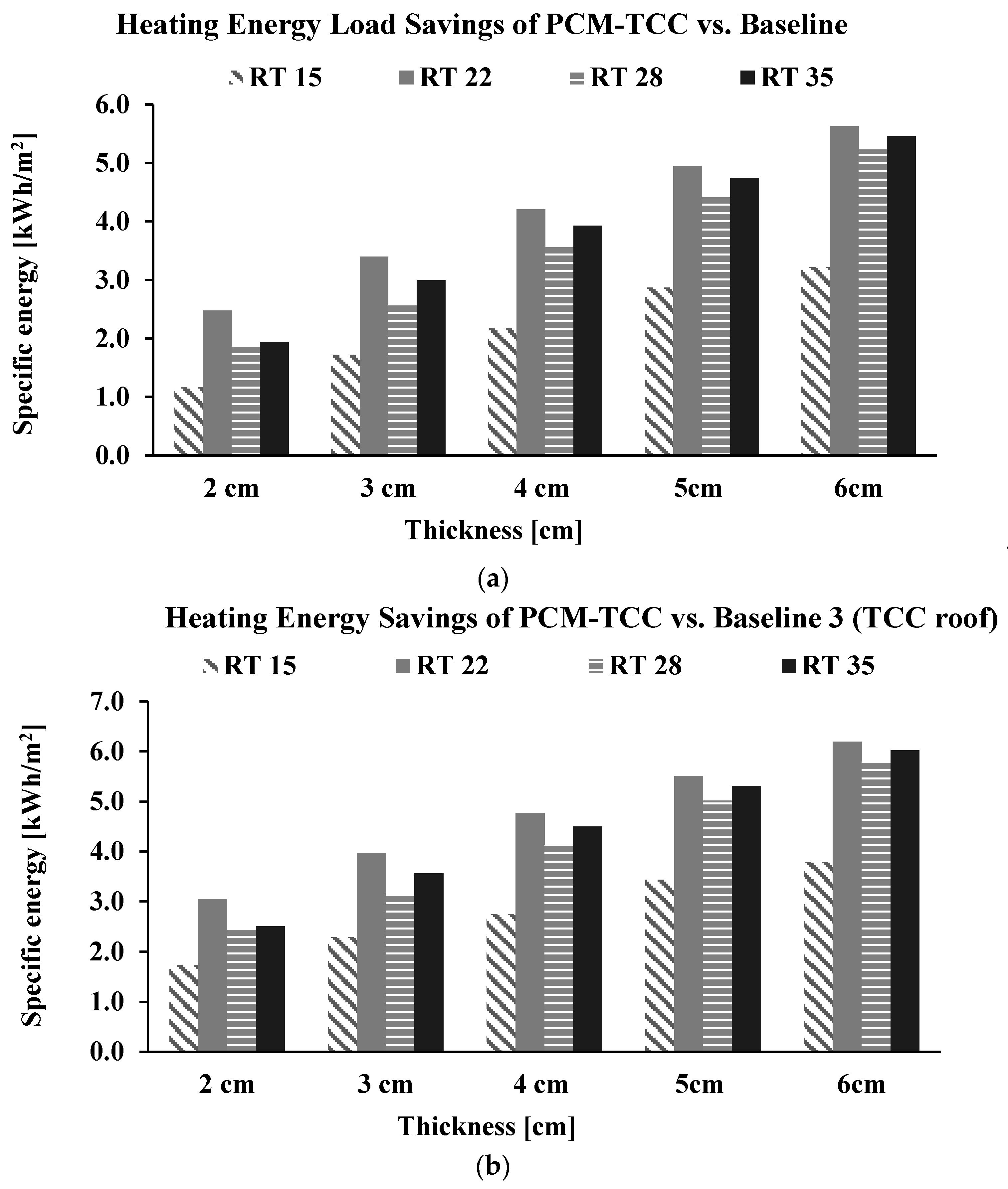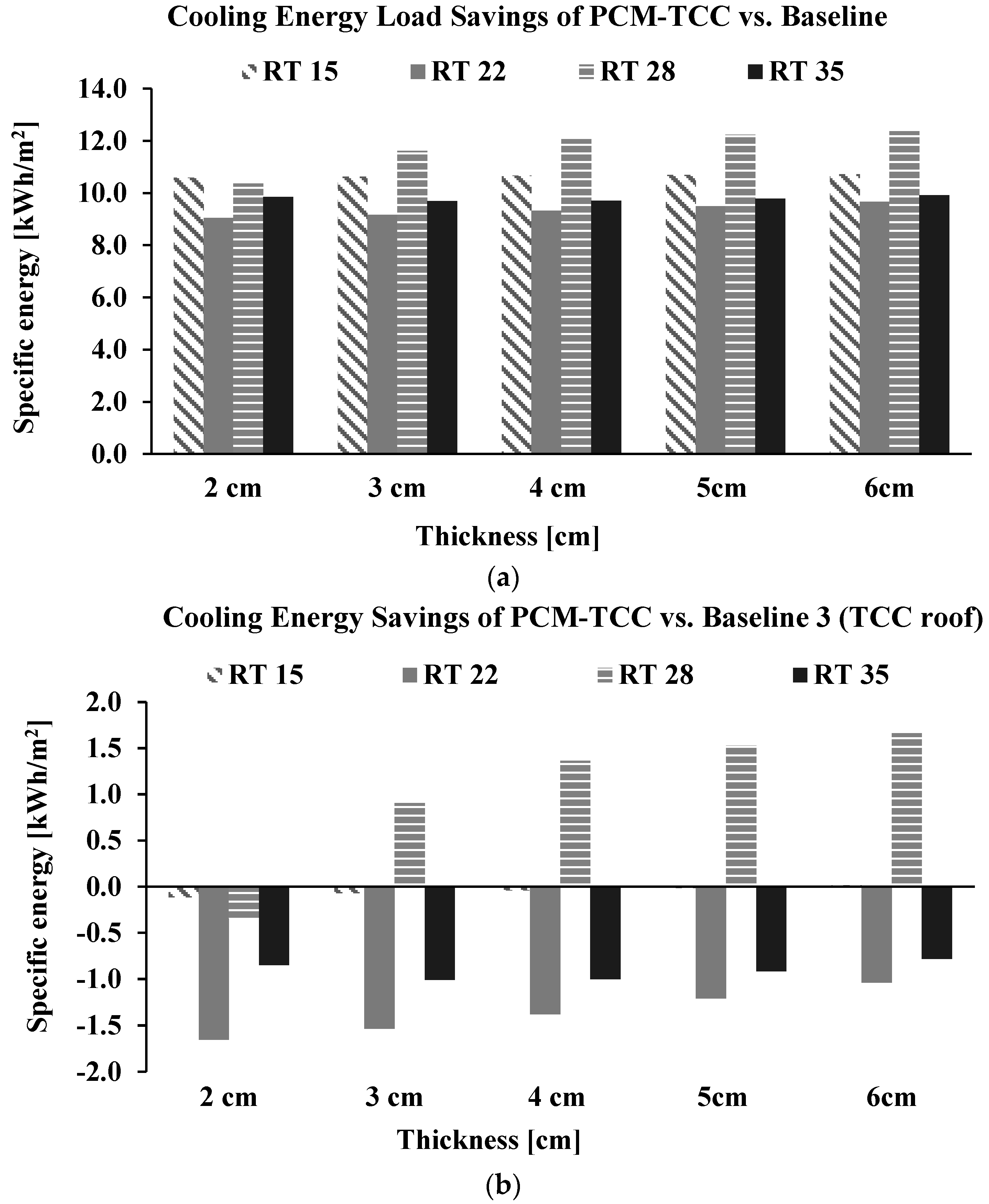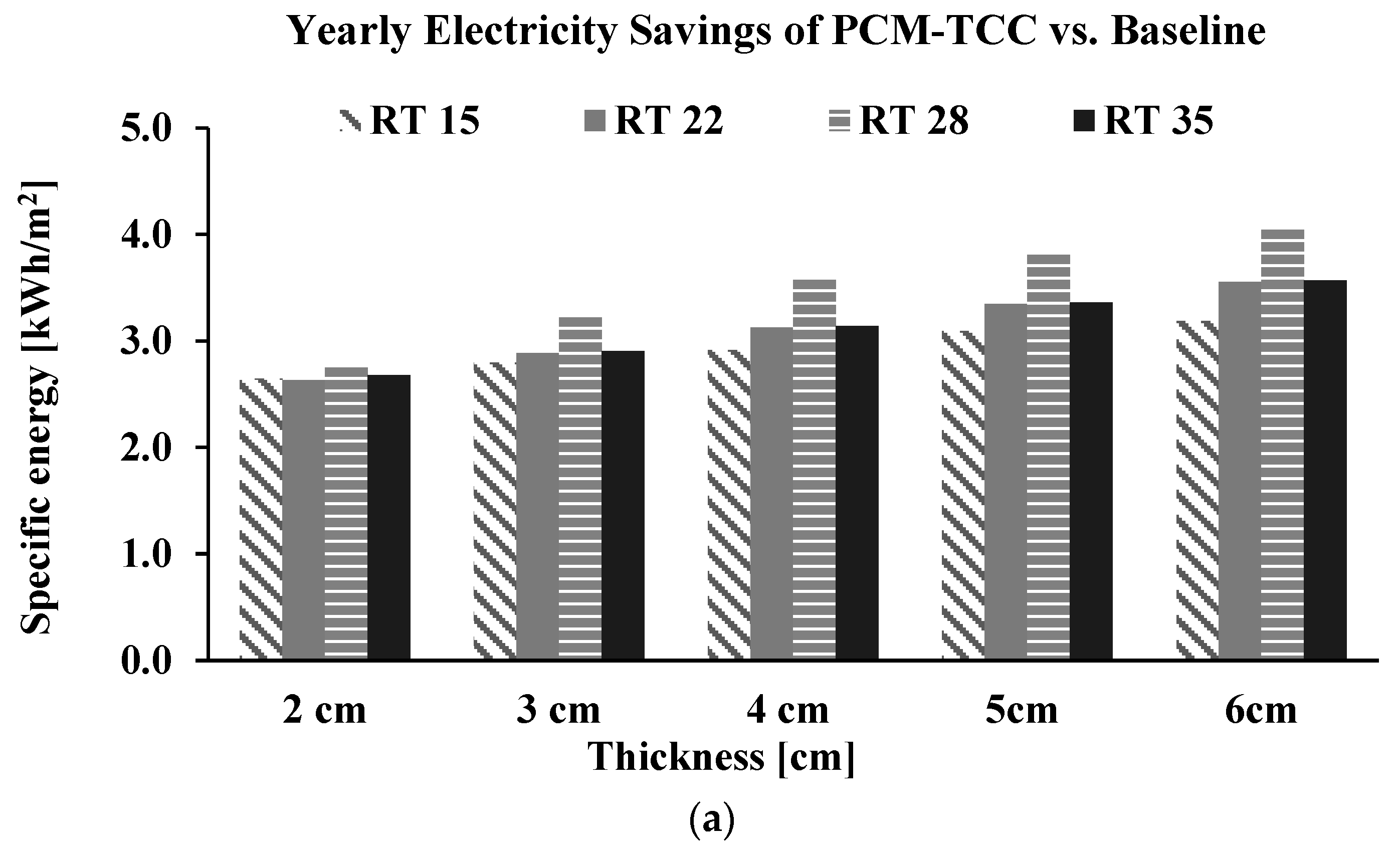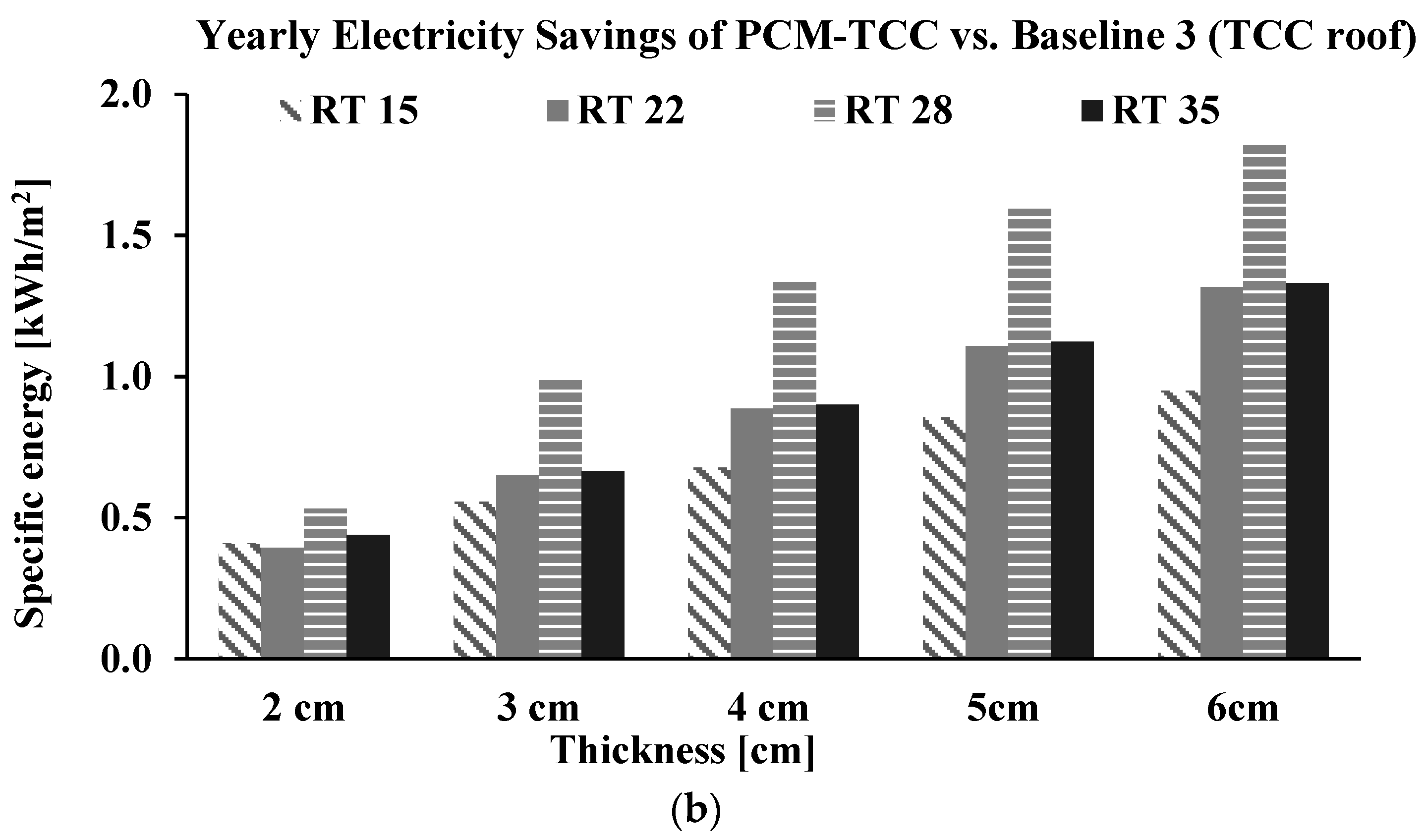1. Introduction
Climate change and rapid global warming pose energy efficiency as an imperative need in the building sector. Predictions about future weather conditions indisputably agree that the global surface temperature will increase by 1.5 °C and 2.0 °C during the 21st century unless radical reductions in emissions of CO
2 and other greenhouse gases take place in the coming decades [
1]. Numerous researchers have studied buildings’ thermal performance when subjected to predicted future weather conditions to evaluate the impact of renovation interventions on the building’s energy equilibrium. Pérez-Andreu et al. [
2], for instance, focused on the Mediterranean climate change conditions and concluded that for every examined scenario, the future energy demand for heating will decrease, whereas, for cooling, it will increase. Pajek and Košir [
3] confirmed that for locations characterized by warmer climates, like the Mediterranean basin, the cumulative thermal loads of a building will rise, as opposed to other locations with colder climates in which a building’s thermal needs will be mitigated. In this alignment, Zhai and Helman [
4], as well as Ciancio et al. [
5] predicted, that the increment in a building’s cooling demand will not be counterbalanced by the decrease in its heating demand, leading to an overall increase in global energy use. Therefore, energy efficiency interventions that first focus on shielding the building against adverse summer conditions should be prioritized for cities with warmer climates.
An effective strategy to restrict a residential building’s cooling loads is to enhance the thermal and optical properties of its roofing system [
6]. Solar heat gains stemming from the roof’s exposure to high-intensity solar irradiation account for a significant part of the building’s cooling thermal loads [
7]. According to the most recent report of the Hellenic Statistical Authority for the period 2011–2021 [
8], the most energy-consuming type of building is the single-family house, with a mean primary energy consumption of 502.3 kWh/m
2. For the city of Athens and the wider region of Attica, single-family houses represent 18% of the city’s households. More than half of these households, specifically 56%, were built before 1980, and therefore, no energy efficiency measures were applied at the time of the construction. According to the available statistical analysis data retrieved from the energy performance certificates, only 2.9% of the country’s single-family houses have undergone energy efficiency renovations. Consequently, a properly structured renovation strategy for family houses with roofs should inarguably include the renovation of their existing roofing system.
Except for reinforcing the thermal resistance of a building’s core, the utilization of high thermal mass materials is also indicated as an energy efficiency tactic [
9]. The integration of phase change materials (PCMs) into the building’s envelope as a passive energy efficiency system [
10] can improve a building’s thermal inertia [
11], acting as a heat transfer modulator between the living space of a building and the ambient [
12]. These materials present high heat capacity storage due to their latent heat storage mechanism in small temperature intervals, absorbing sensible heat in almost isothermal processes [
11]. Additionally, Beemkumar et al. [
13] and Pasupathy et al. [
14] observed that the incorporation of PCM on a building’s roof regulates the fluctuation of the room’s temperature, restricting the mean peak indoor temperature by 1–2 °C and therefore enhancing the thermal comfort conditions. The PCM parameters, namely, thickness, latent heat, location on the building envelope, and phase change transition temperature range, should be properly adapted to a location’s climatic characteristics to achieve optimal energy savings [
15]. More specifically, Hamza et al. [
16] focused their study on air-conditioned residences and concluded that the application of the PCM layer on the building’s roof induces the maximum possible energy savings. Moreover, Jayalath et al. [
17] concluded that a PCM roof layer with a mean transition temperature of 23 °C can lead to a 39% reduction in energy consumption for cooling and a 12% reduction in energy consumption for heating for a one-story residential building in Melbourne. Regarding various areas with a Mediterranean climate, Dardouri et al. [
18] calculated that the modulation of the PCM layer on the roof has an immediate effect on the building’s thermal loads, leading to a cumulative energy reduction in the range of 8% to 31.5%.
White, highly reflective, artificial roof coatings are a commercial [
19] and widely tested solution for the mitigation of the building’s sector cooling loads [
20], especially for areas suffering from extreme heat waves [
21]. Cool materials are defined by high solar reflectivity, higher than 70% [
22], and high infrared emittance, higher than 75% [
22], and therefore by a lower surface temperature compared to traditional materials when exposed to solar irradiation, abating the solar heat penetration to the interior [
23]. Despite their high initial optical properties, artificial cool materials are prone to optical ageing, namely, diminishing solar reflectivity [
24]. According to laboratory testing of white paints used as cool roofing coatings conducted by Antonaia et al. [
25], acrylic paints display the best performance against photo-degradation. Despite their efficiency on a seasonal level, cool roof coatings may lead to an increase in energy demand during the heating period [
26]. To counterbalance this drawback, cool materials and PCMs can be used as complementary retrofit techniques, negating the increase in heating demand and contributing to the building’s cooling performance [
27]. Triano-Juárez et al. [
28] examined the installation of a PCM roof on a building in Mexico, with and without the application of reflective paint. The results indicated a 22% reduction in the cooling thermal load for the PCM roof with a non-reflective, grey coating and a minimum reduction of 58% for the PCM roof with the reflective coating. Lei et al. [
27] calculated for the city of Singapore that the combination of PCM and a cool roof leads to 8.5% yearly energy savings, whereas the PCM roof leads to 1.4%. Similarly, Xu et al. [
29] proved the superiority of the PCM roof with a cool coating to the cool roof in terms of yearly energy consumption for thermal loads, explaining that as heating demand increases, the advantages of the cool roof coating reduce, whereas the efficiency of PCM is strengthened.
Thermochromic coatings (TCC) are thermally adaptive materials that reversibly alter their optical properties as a function of the surface temperature [
23]. The commercially available category of thermochromic materials is leuco dye-based thermochromic materials, which, however, are susceptible to photo-degradation [
30]. The integration of PCMs with TCC allows synergy between the dynamic properties of the two technologies, allowing a balanced management of a building’s heating and cooling demands [
31]. Hu and Yu [
32] studied a TCC roofing system, including an external PCM layer, and calculated that the total energy savings can reach up to 29% for various climatic zones of China. In another study for multiple cities in China, they examined three different roofing systems, namely, a thermochromic roof, a roof with a PCM external layer, and a thermochromic roof with a PCM external layer [
33]. The yearly energy reduction can reach up to 13%, 15%, and 17%, respectively, with better performance for locations with a mild climate. Finally, Ji and Li [
34] compared a PCM roof and a PCM with a TCC roof for the city of Shanghai, a city defined by both heating and cooling needs. They calculated that the PCM with a TCC roof outperformed the PCM roof by 39% in terms of yearly energy savings as well as in terms of performance of the phase change cycle of the PCM.
In this study, the application of a PCM roof, as well as the combination of a PCM roof with a cool coating or a thermochromic coating, is examined for a typical one-story residential building and the Mediterranean climatic conditions of Athens. The building energy simulation is conducted in DesignBuilder software [
35] and aims to investigate the impact of the PCM roof on the building’s thermal loads in a location with hot summers and cool winters. Four different commercially available PCMs are simulated, with mean phase transition temperatures between 15 °C and 35 °C and a variable PCM layer thickness between 2 cm and 6 cm. The integration of PCM with optically innovative materials is considered an alternative and novel solution for the improvement of a building’s thermal response. Also, this study enriches the limited literature as far as the applications of PCM with TCCs are concerned [
34] and examines the application of cool coatings (CCs) as a perennially appropriate retrofit solution. Therefore, the scope of this study is to systematically evaluate the synergy between PCM, CC, and TCC solutions, something that is missing from the current literature and can lead to significant energy savings. More specifically, a commercially available acrylic white paint with a high reflectivity index equal to 0.86 is used as a cool roof coating, whereas a thermochromic paint with a mean transition temperature of 34 °C and a variable reflectivity index of 0.42 and 0.72 is used as a thermochromic coating. The energy efficiency interventions on the building’s roof are thoroughly investigated and compared, as far as their energy savings potential is concerned.
4. Discussion
The integration of PCM material externally into the building’s roof is computed to result in important energy load savings for the climatic conditions of Athens. However, the improper combination of a PCM’s mean transition temperature and thickness proves to be ineffective or have a negative impact on a building’s energy equilibrium.
Table 4,
Table 5 and
Table 6 summarize the building’s heating, cooling, and electricity loads for the optimum PCM, PCM-CC, and P-TCC examined roof systems.
For the heating design, the most efficient PCM is RT22, characterized by a lower mean transition temperature of 22 °C. On the other hand, for the cooling design, the most effective PCM is RT28, defined by a higher mean transition temperature of 28 °C. The highest possible seasonal thermal load energy savings are achieved with a PCM defined by a mean transition temperature similar to the building’s seasonal indoor temperature setpoint. This conclusion is validated by the study of Dardouri et al. [
18], who focused their study on various locations of Mediterranean climatic conditions in Tunisia and calculated that a PCM with a lower melting temperature of 21 °C is more effective for maximizing heating energy savings, while a PCM with a higher melting temperature of 29 °C allows higher cooling energy savings. Additionally, the increase in the PCM’s thickness allows the reduction of the cumulative electricity demand for heating and cooling, with the reduction ranging from 5.65% to 13.55%. For the city of Athens, RT28 is calculated to result in the maximum electricity savings at every thickness. This is explained by the effectiveness of PCMs in reducing the building’s cooling energy loads, as Jayalath et al. [
17] have also concluded in their study for the location of Melbourne. According to their study, as far as the heating thermal loads are concerned, the integration of PCM into a building’s roof can lead to energy savings of 12%. This result is in agreement with the energy savings calculations for heating for the PCM roof system in the present study (6.81% to 15.07%).
The integration of cool coating into the PCM roof system leads to further cooling energy savings when compared to the PCM roof system, as Lei et al. [
27] also established. However, for the climatic conditions of Athens, PCM and CC are proven to have no complementary effect on reducing the building’s cooling energy loads, since a CC roof system is calculated to contribute to higher cooling energy savings (46.3%) than the PCM-CC roof system (43.37% to 45.36%). Additionally, the increase in the PCM’s thickness merely increases the cooling load’s energy savings. However, as far as the total electricity demand is concerned, the PCM-CC roof system presents superior performance to the PCM system. Specifically, the PCM roof system results in a 5.65% to 13.55% reduction of the total electricity demand, whereas the PCM-CC roof system results in a 10.21% to 16.04% reduction for the respective PCM thickness values. This result is also confirmed by the study of Xu et al. [
29], who researched the optimization of the cool coatings applicability in buildings through their integration with PCMs.
The integration of PCM with TCC is calculated to demonstrate both heating and cooling energy savings, which is a fact confirmed by the study of Ji and Li [
34]. Specifically, the PCM-TCC roof system results in the highest heating and cooling energy savings among the PCM, PCM-CC, and PCM-TCC roof systems, and therefore in the highest electricity savings (14.82% to 21.70%). Furthermore, in contrast to cool coating and PCM, thermochromic coating and PCM present a complementary relationship in the reduction of the building’s total electricity demand, according to
Table 6. Specifically, the PCM roof system is calculated to decrease the building’s cumulative electricity consumption by up to 13.55%, while the PCM-TCC reduction is up to 21.70%. The study of Hu and Yu [
33] also proved the superiority of the PCM-TCC roof system against the PCM roof system as far as mild climates are concerned. Specifically, they found that the integration of a PCM-TCC roof system can lead to energy savings for heating and cooling equal to 17%, a result that is in agreement with the energy savings calculations for the examined building in the present study.
